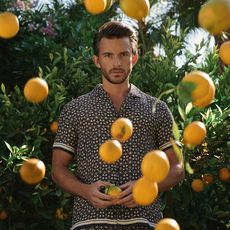THE STORY BEHIND THE ICONIC OCEAN PHOTOGRAPH
To celebrate World Ocean Day, we talk to Noel Guevara about going viral and life beneath the seas
Over two hundred events around the world will mark World Ocean Day on 8th June. From #swimfortheocean in Lima to beach clean-ups in Gabon. Its 30x30 campaign seeks to get world leaders to agree to protect at least 30% of the oceans by 2030. To do this, the project is calling for the much-needed creation of Marine Protected Areas, which would act like national parks on land, and curb the excesses of humanity in the water.
To say this is necessary is an understatement, the ocean covers 70% of the planet, the world’s oceans produce 50% of oxygen and is the main source of protein for more than a billion people worldwide. And yet despite its vital role in our survival, over 90% of its fish populations have shrunk, and 50% of its coral reefs.
At Orlebar Brown we are proud to support World Ocean Day and to mark it, we spoke to 38-year-old Manila-based photographer Noel Guevara. Few others have brought such close attention to the problems – and indeed the wonders – beneath the waves. His photographs frequently go viral and with good cause.
Here, he chooses four of his favourites which showcase what life is really like in our oceans.
Caban Cove, Maricaban Island, Verde Island Passage (above)
“I took this on assignment with Greenpeace back in 2019 and it has to be my most famous photo. I was doing a visual audit underwater in the centre of the Coral Triangle. People discover new ocean species there every day. We wanted to contrast that with how much plastic was also there. At the end of the day, when I was just leaving, I saw this cup floating and started taking photos of it. The next thing I knew, there was a crab inside it. I knew it would be an iconic shot, at least for the campaign. What I didn't know was that it would explode virally all over the world. It was picked up by the BBC, CNN, and National Geographic and it was on the front pages of broadsheets in Milan and France. The plastic cup is from a brand based in the Philippines and served pretty much everywhere; it goes to show how much single-use plastic ends up in our oceans.”
Thresher Shark and Divers, Monad Shoal, Malapascua Island, 2015
“Most of the time sharks are timid, shy and skittish. They aren’t very charismatic creatures. I posted it and here in the Philippines people started to ask questions about it, about the sharks. This photo launched my career. People asked why the sharks weren’t attacking the divers. People think sharks are all going to attack you. The reality is far from that. I like to think this photo helped to increase protections in the International Union for Conservation of Nature. It helped to break down some of that stigma surrounding sharks. When I think about my purpose in life, this photo sums it up.”
Seaweed farmers, Taytay, Palawan, 2017
“These seaweed farmers used to be involved in dynamite fishing and cyanide fishing, but now have an alternative means of livelihood – in this case, seaweed farming. Palawan in the Philippines is known for some of the best beaches in the world. I took this for the Asian Development Bank, during a project with the Coral Triangle Initiative. This NGO aims to increase the climate resiliency of communities – those most affected by climate change. It’s a fantastic enterprise. They have grown into a community-wide enterprise and they have their own union, too. I believe you should be inclusive when you approach conservation – less ‘don’t do that' and more ‘what about this instead?’. It is a photo which speaks to the theme of this year’s World Ocean Day.”
Green Sea Turtle feeding on seagrass in Balicasag Island, Bohol, Philippines.
“The Marine Protected Area (MPA) has a thriving biodiversity. Green Sea Turtles are endangered and face a multitude of threats. Coastline developments reduce their nesting grounds, sometimes ships strike them, and on top of that there is plastic pollution, poaching, and warming oceans to contend with. Similarly, seagrass beds are crucial to reducing carbon in the atmosphere as they too absorb carbon. Per hectare, seagrasses can store up to twice as much carbon as land forests. It’s my favourite turtle shot I’ve taken.”
Discover how to holiday better with the latest range of classic mens swim shorts, a fail safe if you're looking for the perfect balance of comfort and class.


